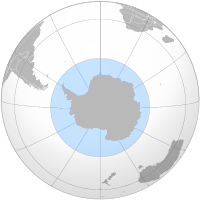
Photo from wikipedia
Mesoscale variability and associated eddy fluxes play crucial roles in ocean circulation dynamics and the ecology of the upper ocean. In doing so, these features are biologically important, providing a… Click to show full abstract
Mesoscale variability and associated eddy fluxes play crucial roles in ocean circulation dynamics and the ecology of the upper ocean. In doing so, these features are biologically important, providing a mechanism for the mixing and exchange of nutrients and biota within the ocean. Transient mesoscale eddies in the Southern Ocean are known to relocate zooplankton communities across the Antarctic Circumpolar Current (ACC) and are important foraging grounds for marine top predators. In this study we investigated the role of cyclonic and anti-cyclonic eddies formed at the South-West Indian Ridge on the spatial variability and diversity of microbial communities. We focused on two contrasting adjacent eddies within the Antarctic Polar Frontal Zone to determine how these features may influence the microbial communities within this region. The water masses and microbiota of the two eddies, representative of a cyclonic cold core from the Antarctic zone and an anti-cyclonic warm-core from the Subantarctic zone, were compared. The data reveal that the two eddies entrain distinct microbial communities from their points of origin that are maintained for up to ten months. Our findings highlight the ecological impact that changes, brought by the translocation of eddies across the ACC, have on microbial diversity.
Journal Title: PLoS ONE
Year Published: 2017
Link to full text (if available)
Share on Social Media: Sign Up to like & get
recommendations!